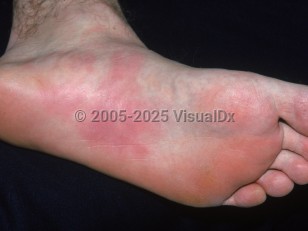Pressure urticaria in Child
Alerts and Notices
Important News & Links
Synopsis

Pressure urticaria is a type of chronic, physical, inducible urticaria characterized by a wheal-and-flare response of the skin to sustained pressure stimuli. It is usually a chronic condition that lasts for more than 6 weeks. Presumably, it occurs by a pressure-related mechanism that results in mast cell degranulation with release of histamine.
Pressure urticaria can be seen in newborns and young infants and most often involves the feet and lower legs as well as the torso, but it may involve other parts of the body. It is unknown if this causes physical discomfort such skin burning, pain, or itching in infants as reported in adult patients. Pressure urticaria has less commonly been described in children.
Pressure urticaria may be induced by pressure from elastic bands of clothing (socks), undergarments, car seat or baby swing straps, and cushions. It may also be seen when infants repetitively kick their feet against an object. Older children may have involvement where straps of backpacks or sports equipment contact the skin.
Occasionally, the lesions of pressure urticaria may be mistaken as unexplained bruises or physical abuse that may result in unnecessary child protective referrals. Pressure urticaria is thought to be uncommon, but the true incidence is unknown.
Two forms of pressure urticaria are recognized: immediate pressure urticaria (IPU), also known as dermographism, and delayed pressure urticaria (DPU). In IPU, swelling and erythema of the skin begin within minutes of the offending pressure stimulus, versus DPU, which takes 4-8 hours for a reaction to develop.
Lesions in pressure urticaria may last for 8-72 hours, a range that is much longer than that of most other forms of urticaria.
Systemic symptoms including wheezing, hypotension, and fevers are very uncommonly seen in infants.
Pressure urticaria can be seen in newborns and young infants and most often involves the feet and lower legs as well as the torso, but it may involve other parts of the body. It is unknown if this causes physical discomfort such skin burning, pain, or itching in infants as reported in adult patients. Pressure urticaria has less commonly been described in children.
Pressure urticaria may be induced by pressure from elastic bands of clothing (socks), undergarments, car seat or baby swing straps, and cushions. It may also be seen when infants repetitively kick their feet against an object. Older children may have involvement where straps of backpacks or sports equipment contact the skin.
Occasionally, the lesions of pressure urticaria may be mistaken as unexplained bruises or physical abuse that may result in unnecessary child protective referrals. Pressure urticaria is thought to be uncommon, but the true incidence is unknown.
Two forms of pressure urticaria are recognized: immediate pressure urticaria (IPU), also known as dermographism, and delayed pressure urticaria (DPU). In IPU, swelling and erythema of the skin begin within minutes of the offending pressure stimulus, versus DPU, which takes 4-8 hours for a reaction to develop.
Lesions in pressure urticaria may last for 8-72 hours, a range that is much longer than that of most other forms of urticaria.
Systemic symptoms including wheezing, hypotension, and fevers are very uncommonly seen in infants.
Codes
ICD10CM:
L50.8 – Other urticaria
SNOMEDCT:
387787005 – Pressure urticaria
L50.8 – Other urticaria
SNOMEDCT:
387787005 – Pressure urticaria
Look For
Subscription Required
Diagnostic Pearls
Subscription Required
Differential Diagnosis & Pitfalls

To perform a comparison, select diagnoses from the classic differential
Subscription Required
Best Tests
Subscription Required
Management Pearls
Subscription Required
Therapy
Subscription Required
References
Subscription Required
Last Reviewed:08/30/2022
Last Updated:09/11/2022
Last Updated:09/11/2022
Pressure urticaria in Child

